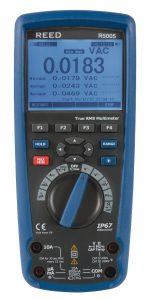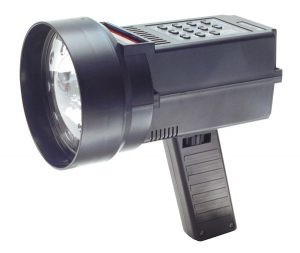Thermography, Meters and Scopes: Tech Tools for the 21st-Century Electrical Maintenance Professional
Repairing and preserving modern electrical equipment requires up-to-the-minute tools for commercial and industrial plant maintenance programs. But when it comes to advanced technology, maintenance professionals have generally been faced with a frustrating compromise: Expensive price tags or bulky designs. Infrared Thermography or Thermal Imaging (IRT), meters and stroboscopes offer a solution to that aggravation.
Infrared Thermography
Infrared Thermography offers electrical maintenance personnel a cost competitive, user-friendly choice over traditional single point IRT counterparts. Its non-contact, mobile design makes it safe to measure temperature, even in the tightest, most awkward locations.
Thermal Imaging is especially beneficial in preventing risks and failures in electrical and mechanical applications. IRTs scan, visualize and analyze temperatures of equipment, trouble-shoot multilayer electronic and circuit boards, and electrical systems quickly and accurately. Routine electrical inspections using thermal imaging cameras can help prevent unexpected outages and reduce risk and insurance liability for manufacturers and industrial plants.
Today’s IRT cameras are three times more sensitive, five times faster, and capable of capturing video, not just photos, and are generally less than $4,000, compared to early models, which neared the $20,000 price range. Infrared Thermography technology like the REED Thermal Imager (R2100) features color TFT LCD capacitive touch screen, high thermal sensitivity, built-in laser and visible light digital camera, 7.5mm lens, 20x continuous zoom, just to name a few, and is suitable for all the applications listed here, and many more.
Meters and Stroboscopes
Predictive maintenance programs also benefit from the use of modern tech devices like multimeters, vibration meters, tachometers, stroboscopes and clamp meters for electrical and mechanical inspections.
Multimeters or multitesters, like the REED True RMS Multimeter [R5005] combine the functionality of ammeters, volt meters and ohm meters to diagnose problems in electrical equipment wiring and power supplies. Connect the meter to a circuit or piece of equipment to see voltage, current, resistance, capacitance, frequency, duty cycles and temperature measurements.
Vibration can be an indicator of your equipment’s condition, like gear wear, misalignment of couplings or looseness. Vibration meters and data loggers aid maintenance professionals in collecting balance and alignment data of rotating and moving equipment by measuring velocity and acceleration to detect when equipment is developing a problem. Devices like the REED Vibration Meter/Data Logger [SD-8205] offer a high degree of accuracy with a +/-5% and a 0.5 to 199.9 mm/s velocity range with 0.1 mm/s resolution and an easy to read LCD display with backlight.
An essential tool for every electrical maintenance professional, voltage/current data loggers, measure both current and voltage and can detect electrical currents in cables, cords, circuit breakers, switches, writing and other components of your commercial systems. These meters test for live circuits and proper grounding. Meters like the REED AC Voltage/Current Data Logger [R5003] are a two-channel AC device for monitoring and logging data and stores up to 256,000 measurements, which can be downloaded to a PC through the USB interface.
Industrial technicians and maintenance personnel can use clamp meters to repair systems, troubleshoot installation problems, and perform scheduled services. Clamp meters are diagnostic tools that combine digital multimeters with a current sensors and have two jaws that fit around a conductor to a to measure currents, voltage, resistance, continuity, capacitance, temperature and frequency, all without cutting through wires or touching or interrupting the electrical circuit. A clamp meter like the REED AC/DC Clamp Meter [R5020] is an average-sensing, auto-ranging multimeter with a clamp that measures AC and CD to 400A, and is equipped with a rotary switch to select the property to measure, and a 4,000-count LCD with a backlight for visibility in low light.
When measuring the speed of motors, conveyer belts and other moving systems is critical, electrical maintenance personnel can rely on contact and photo tachometers to safely collect the data. Tachometers measure the RPM of motors and machine parts with a visible red light beam from a powerful LED. Apply a reflective mark onto the target object and aim the beam at the mark to get an RPM display. Devices like the REED Contact/Photo Tachometer [ST-6236B] measure from 10 to 99,999 RPM for non-contact measurements and from 0.5 to 19,999 RMP for contact measurements with a +/-0.05% accuracy and takes non-contact measurements using a laser beam from 50 to 500mm for user safety.
Similar to the tachometer is the stroboscope, another great tool that assists maintenance personnel in assessing stresses and measuring speed on moving gears, fans, pumps, mowers and other rotating equipment, but without the need for reflective tape. The stroboscope “freezes” the motion and measures the speed of the rotating object without the need for contact. Stroboscopes like the REED Stroboscope [K4030] has a push bu tton that doubles, and one that divides the flashing light in half and displays the rate with just one activation. It also features coarse and fine adjustment buttons to synchronize the flash to exactly the right rate.
Portability and cost competiveness have made thermal imaging and meter technology a viable, safe solution for any preventive and predictive maintenance program when working in inconvenient, low-visibility locations isn’t an option.
Source: Reed Instruments


